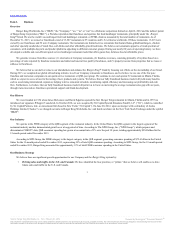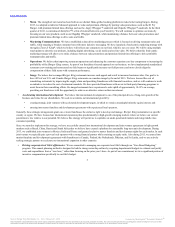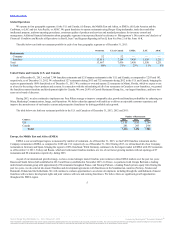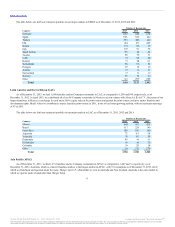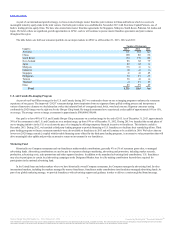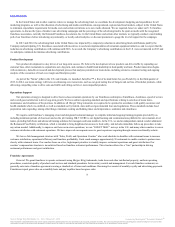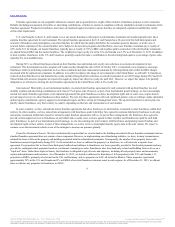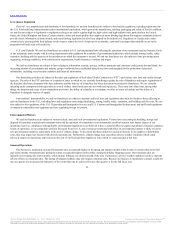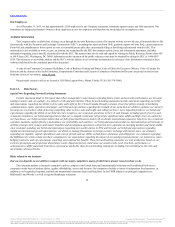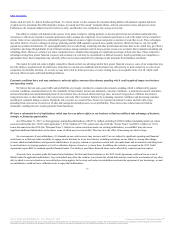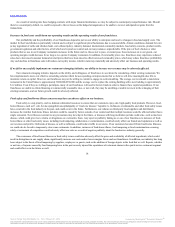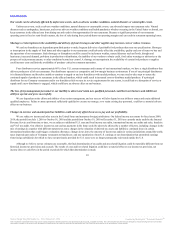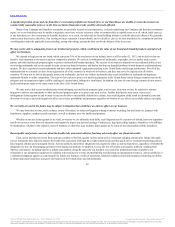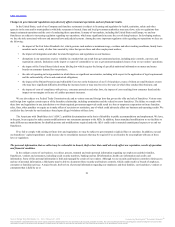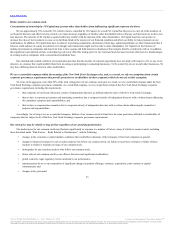Burger King 2013 Annual Report Download - page 15
Download and view the complete annual report
Please find page 15 of the 2013 Burger King annual report below. You can navigate through the pages in the report by either clicking on the pages listed below, or by using the keyword search tool below to find specific information within the annual report.
Table of Contents
chains, such as Carl’s Jr., Jack in the Box and Sonic. To a lesser extent, we also compete for consumer dining dollars with national, regional and local
(i) quick service restaurants that offer alternative menus, (ii) casual and “fast casual” restaurant chains, and (iii) convenience stores and grocery stores.
Furthermore, the restaurant industry has few barriers to entry, and therefore new competitors may emerge at any time.
Our ability to compete will depend on the success of our plans to improve existing products, to develop and roll-out new products and product line
extensions, to effectively respond to consumer preferences and to manage the complexity of our restaurant operations as well as the impact of our competitors’
actions. Some of our competitors have substantially greater financial resources, higher revenues and greater economies of scale than we do. These advantages
may allow them to (1) react to changes in pricing, marketing and the QSR segment in general more quickly and more effectively than we can, (2) rapidly
expand new product introductions, (3) spend significantly more on advertising, marketing and other promotional activities than we do, which may give them a
competitive advantage through higher levels of brand awareness among consumers and (4) devote greater resources to accelerate their restaurant remodeling and
rebuilding efforts. Moreover, certain of our major competitors have completed the reimaging of a significant percentage of their store base. These competitive
advantages arising from greater financial resources and economies of scale may be exacerbated in a difficult economy, thereby permitting our competitors to
gain market share. Such competition may adversely affect our revenues and profits by reducing royalty payments from franchise restaurants.
The market for retail real estate is highly competitive. Based on their size advantage and/or their greater financial resources, some of our competitors may
have the ability to negotiate more favorable lease terms than we can and some landlords and developers may offer priority or grant exclusivity to some of our
competitors for desirable locations. As a result, we may not be able to obtain new leases or renew existing leases on acceptable terms, if at all, which could
adversely affect our sales and brand-building initiatives.
We believe that our sales, guest traffic and profitability are strongly correlated to consumer discretionary spending, which is influenced by general
economic conditions, unemployment levels, the availability of discretionary income and, ultimately, consumer confidence. A protracted economic slowdown,
increased unemployment and underemployment of our customer base, decreased salaries and wage rates, increased energy prices, inflation, foreclosures,
rising interest rates or other industry-wide cost pressures adversely affect consumer behavior by weakening consumer confidence and decreasing consumer
spending for restaurant dining occasions. During the last recession, as a result of these factors we experienced reduced revenues and sales deleverage,
spreading fixed costs across a lower level of sales and causing downward pressure on our profitability. These factors also reduced sales at franchise
restaurants, resulting in lower royalty payments from franchisees.
As of December 31, 2013, we had aggregate outstanding indebtedness of $2,951.1 million, including $1,680.8 million outstanding under our senior
secured credit facility (the “2012 Credit Agreement”), $794.5 million of 9 7/8% senior notes due 2018 (the “Senior Notes”) and $453.1 million of 11.0%
senior discount notes due 2019 (the “Discount Notes”). Subject to certain restrictions under our existing indebtedness, we and BKC may also incur
significant additional indebtedness in the future, some of which may be secured debt. This may have the effect of increasing our total leverage.
As a consequence of our indebtedness, (1) demands on our cash resources may increase and (2) we are subject to significant operating and financial
restrictions on us that may limit our ability to engage in acts that may be in our best interest, including restrictions on our ability to, among other things,
(i) incur additional indebtedness and guarantee indebtedness, (ii) prepay, redeem or repurchase certain debt, (iii) make loans and investments, including loans
to our franchisees or strategic partners, (iv) sell or otherwise dispose of assets or (v) incur liens. In addition, the restrictive covenants in the 2012 Credit
Agreement require BKC to maintain specified financial ratios. Our ability to meet those financial ratios can be affected by events beyond our control.
A breach of our covenants under the Senior Notes Indenture, the Discount Notes Indenture or the 2012 Credit Agreement could result in an event of
default under the applicable indebtedness. Any such default may allow the creditors to accelerate the related debt and may result in the acceleration of any other
debt to which a cross-acceleration or cross-default provision applies. In the event our lenders or noteholders accelerate the repayment of our borrowings, we and
our subsidiaries would not have sufficient assets to repay that indebtedness.
13
Source: Burger King Worldwide, Inc., 10-K, February 21, 2014 Powered by Morningstar® Document Research℠
The information contained herein may not be copied, adapted or distributed and is not warranted to be accurate, complete or timely. The user assumes all risks for any damages or losses arising from any use of this
information, except to the extent such damages or losses cannot be limited or excluded by applicable law. Past financial performance is no guarantee of future results.


